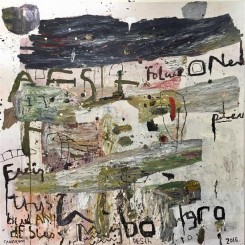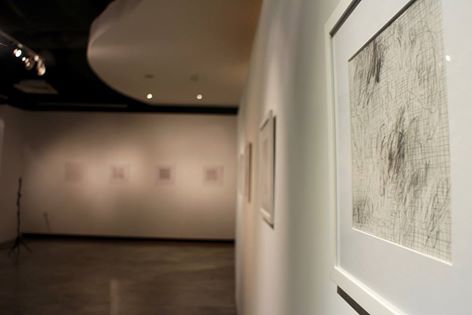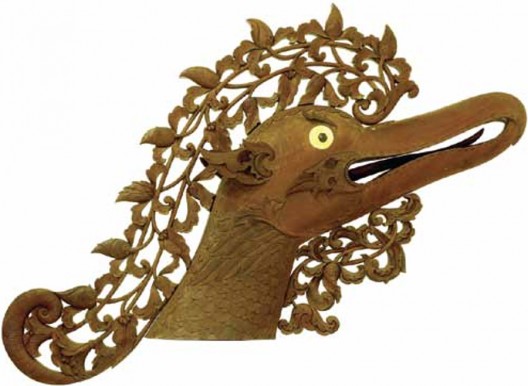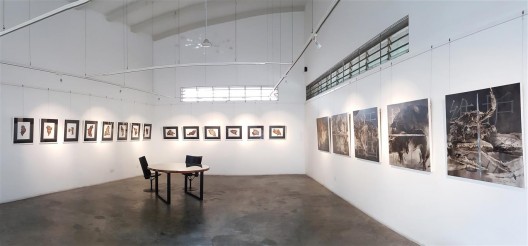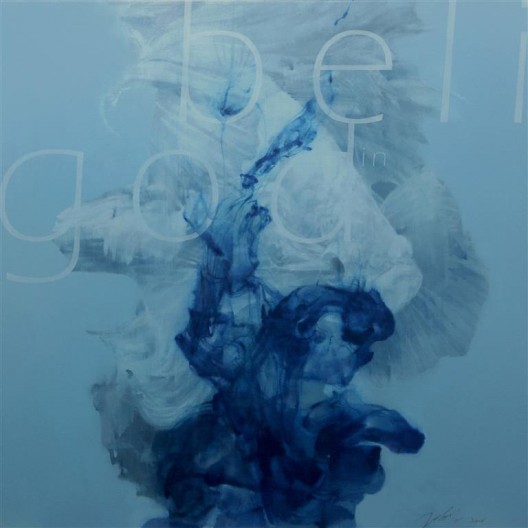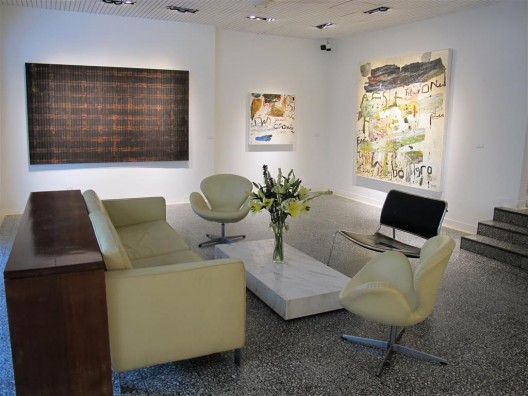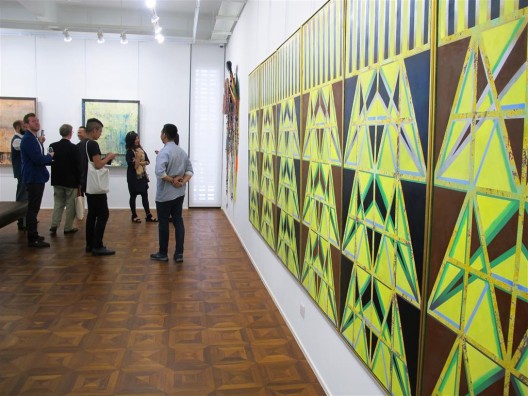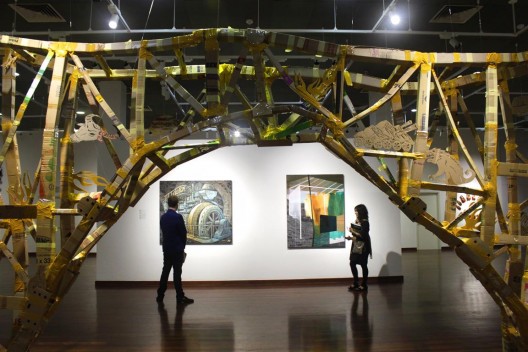Like your average snobby Singaporean, my first thought on hearing of KL’s inaugural gallery weekend (misheard as a gallery “week”) was: “Really? Are there enough galleries?” Reminding myself that I was being a prat, I found that that skepticism extends even to the Malaysian government, who provided no financial support on this occasion—though it may be that their plate is a little full at the moment. There is, however, some optimism around the idea that a successful first Weekend might convince the state to throw their weight behind future editions, with the date of the second edition is December 8 – 11, 2017.
“Matter at Hand”
Galeri Chandan (Lot 24 & 25 (G4), Block C5, Publika Shopping Gallery, Jalan Dutamas 150480 Kuala Lumpur, Malaysia), Nov 25 – Dec 25, 2016
It’s not a great look when a gallery opens late on the first day of an event like this, but the view of the skyline rather makes up for it. Like a fair number of Malaysian galleries, Galeri Chandan is based in a shopping mall, with its roots in an architecture and interior design firm.
The gallery is host to “Matter at Hand”, a solo presentation by Mohd Fuad Arif, an artist and lecturer at the Department of Fine Art of Universiti Teknologi Mara (UITM) in Shah Alam. The show also serves as part of his doctoral research, described as a phenomenological engagement with graphite media, and takes the form of a number of graphite-on-paper works which appear to grapple with the roots of mark-making. As dry as the subject is, it’s not helped by a rather inconsistent hang.
“Carbon Copy”
G13 Gallery (GL13, Ground Floor, Block B, Kelana Square, SS7/26 Kelana Jaya, 47301 Petaling Jaya, Selangor, Malaysia), Dec 3 – 17, 2016
Finding yourself surrounded by an eclectic selection of paintings, with carpet underfoot and some couches within easy reach, you might think you’ve got the placed summed up; but nip round the corner and suddenly you are in a white cube space. On display here is “Carbon Copy”, a group show of printmakers from the region, highlights of which include a self-titled woodcut (2015) of Rabindranath Tagore by Jakkee Kongkaew, the elegant simplicity of which belies the meticulous care taken in its production. The dense imagery of Mohamad “Ucup” Yusuf’s prints is also particularly attention-grabbing, blending a propagandistic woodcut aesthetic with more traditional Javanese imagery.
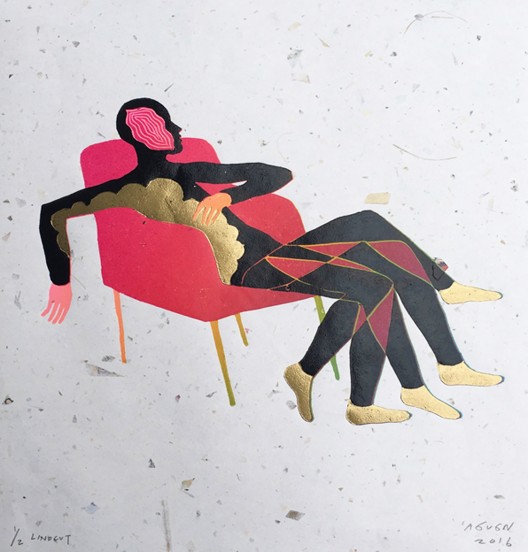
Agung Prabowo, “The Immeasurable III”, linocut reductive print on money waste recycled paper, 27.5 x 33.5 cm, 2016
“Langkasuka—Sacred & Profane.”
NN Gallery (22, Jalan Bukit 11/2, Seksyen 11, 46200 Petaling Jaya, Selangor), Nov 25 – Dec 3, 2016
The presence of a weathered wooden archway before the modern glass and steel entrance of this gallery space suggested, in small part, an exhibition which blurred the lines between art and traditional craft: “Langkasuka—Sacred & Profane”. Featuring the master carver Noorhaiza Noordin and printmaker Ilse Noor, the exhibition was presented by NN Gallery at Curate, a gallery space run by Henry Butcher Art Auctioneers at Seni Mont Kiara which bills itself a “residential resort.”
Organizational details notwithstanding, the show itself displayed an unabashed enthusiasm for each artist’s mastery of their media—in the case of Noorhaiza, wood, and aquatint for Ilse. The carver exerted a more overt influence over the exhibition with his interest in pre-Islamic Malay arts and culture (his keris—traditional double-edged daggers—are especially gorgeous) supplying both the show’s title and its entrance, which was taken from the artist’s own home. Ilse Noor’s subdued yet lavishly detailed images, on the other hand, suggest both spirituality and the fantastical and permeated the show more subtly, one highlight being a series on the traditional architecture of Malaysia.
“Look to See”
Shalini Ganendra Fine Art (@ Gallery Residence), Nov 25, 2016 – Jan 25, 2017
Like some other gallerists in the city, Shalini Ganendra—also the organizer of the gallery weekend—has her gallery in a residential neighborhood, suggesting the relative unimportance of incidental footfall. Where she went one further, though, was in having it purpose-built from the ground up as an example of energy-efficient tropical architecture; rather than the ubiquitous, air-conditioned white cube, her gallery relies for the most part on natural ventilation, yielding not a sense of separation and decontextualization from the world around it, but one of tangibly inhabiting the city.
The exhibition on show, “Look to See”, covers a fair amount of ground: Bibi Chew’s intersections of identity and topography are strongest in deconstructing Malaysia into its constituent states, while Zac Lee’s National Principle series (2016), pairing Malaysia’s national principles with incongruous imagery, would be all the more gripping without the pixelated oval overlay. The newcomer, Mok Yee, vacillates between a sort of staid literalism in “You Feed, I Eat” (2012), and surreal heights with “Wave 75mm” (2014/2016).
“Group Exhibition”
Taksu (17 Jalan Pawang, 54000 Kuala Lumpur, Malaysia), Nov 25 – 27, 2016
No round-up of Kuala Lumpur’s gallery scene could be without one of its most enduring names, the 26-year-old Taksu. Located on what translates to something like Shaman Street on Shrine Hill, the gallery resides in a modernist ’60’s bungalow complete with all the stylistic flourishes of the time—mosaics, for one.
All of this sets the tone for a more relaxed, informal engagement with the artworks on display—as one might live with them, rather than from the forbidding distance of a white cube. Highlights here included the evocative—if somewhat twee—abstract figurative canvases of rising star Fadilah Karim, as well as Zulkifli Lee’s matte metallic grid paintings, which hint at considerable material sensitivity in their gradual oxidation.
“Malaysian Art, a Special Preview”
Richard Koh Fine Art (229 Jalan Maarof, Bukit Bandaraya, Bangsar, 59100 Kuala Lumpur), Nov 22 – 26, 2016
It’s possible—and perhaps more convenient for the collector on the go—to find Richard Koh Fine Art (RKFA) in a mall, but their appointment-only Jalan Maarof venue in a converted residence offers much to those with a little more time on their hands. As one of Malaysia’s more enduring galleries with some eleven years under their belt, RKFA represents and showcases a wide range of practices, with its Gallery Weekend presentation acting as a bit of a preview to their offerings in the coming year.
One of the most engaging bodies of work on display was that of the young multi-disciplinary artist Hings Lim, an untitled series in which domestic workers are engaged to clean up after Lim as he paints on an unstretched canvas drop cloth. What distinguishes Kim’s work from other dialogues between artistic and domestic labor is its simultaneity—in the accompanying video documentation of Lim’s process, the artist and the cleaner stand on the canvas at the same time, co-authoring as much as calling authorship in question. Also there were blob-ular sand and foam sculptures by Haffendi Anuar suggestive of biological structures or curious results of environmental erosion, rendered in acidic, metallic tones—though the manner of their display indicated a somewhat excessive fascination, on the part of the gallery, with acrylic vitrines that were just a little too small.
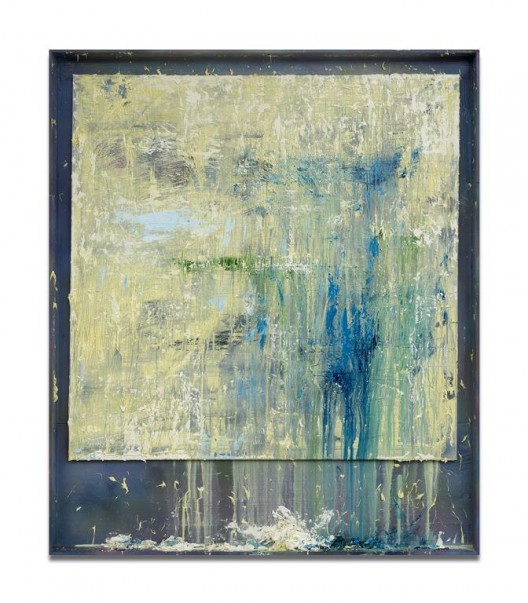
Yeoh Choo Kuan, “00.27″, oil and lacquer on canvas with wooden frames 203 x 143 cm, 2016 at Richard Koh Fine Art
“SAGER: Ties of Tenggara”
National Visual Arts Gallery (Jalan Tun Razak & Jalan Temerloh, Tijani 2 North, 53200 Kuala Lumpur, Wilayah Persekutuan Kuala Lumpur, Malaysia) Nov 15 – Dec 31, 2016
Playing host to a presentation by HOM Art Trans alongside its own exhibition, Malaysia’s National Visual Arts Gallery is a study in extreme contrasts. Its dramatic facade, derived from traditional Malay visual motifs, houses what often feels like a rather grim convention center with chronic maintenance issues which include a leaky roof over one of the gallery spaces. Various conversations over the course of the weekend painted a picture of a moribund institution in need of fresh direction and funding commensurate with the role its name suggests.
The exhibition proper, “SAGER: Ties of Tenggara”, is a decidedly mixed bag. On one hand, the paintings of Seah Zelin and Zean Cabangis evince technical mastery and deep engagement with their chosen medium from entirely individual perspectives. On the other hand, far more of the artworks suggest a startlingly leaden sense of literal-mindedness, as might be seen in Suddin Lappo’s “Red Card” (2016) or “The Subtitle” (2016).
Closing thoughts
One feature of art in Malaysia that takes some getting used to, for an outsider, is its resolutely analog nature, with new media art and other purported hallmarks of the contemporary being far less prominent here. Detractors of art in Malaysia as somehow deficient or undeveloped might be given pause, considering the wider art world’s recent (re)turn to painting and the material. Coming from somewhere less painting-oriented it might come as something of a shock, but acclimatization is fairly simple.
Although this round-up doesn’t include the entire program, the gallery weekend was more than just exhibitions at one gallery after another—lectures by Christopher Phillips of the International Center of Photography and Hanif Kara of AKTII, for instance, added further dimensions of intellectual curiosity. Considerable attention was also devoted to programming outside what might be considered the modern and contemporary art world. For instance, while the phrase “heritage walk” might call to mind some safe, pre-packaged, tourist-friendly tedium, the program led by Nadge Ariffin involved the neighborhood of Kampong Baru, a site of active conflict between examples of traditional architecture and property developers keen to steamroll the lot to accommodate condominiums.

